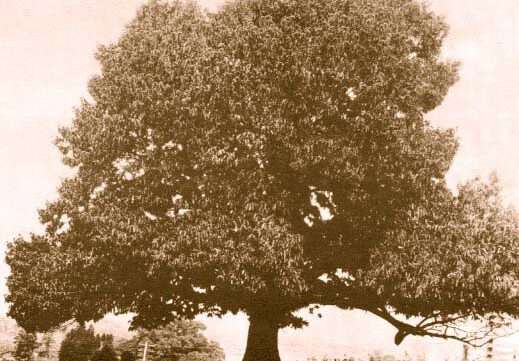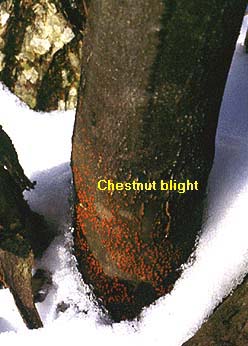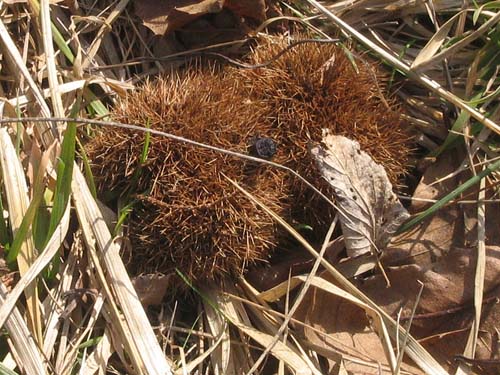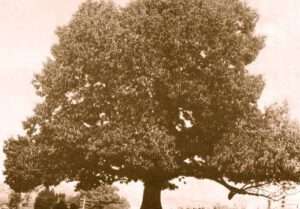
Early McAlexander looks through the window of his granddaughter’s car onto a wide open hill fringed by a line of white pines. “All this land used to belong to my father,” Early says in a voice that’s surprisingly steady and strong for a man of 92. His Virginia accent twists and pulls the vowels like taffy. “I was raised up where that house is now,” he adds, looking in the other direction across the blacktop road to a large, modern red-brick house with a quasi-colonial portico. It’s a far cry from the house in which he and his six brothers and sisters grew up: a four-room log cabin built by his great-great grandfather before the Civil War.
McAlexanders have lived in this area at the crest of the Blue Ridge in Patrick County, Virginia for generations. Early is a dapper, spry man, with a full head of snow-white hair, hearing aids in each ear and liver-spotted hands that are still steady enough to wield a chain saw or guide a tractor-mower (much to his protective granddaughter’s horror.) On this windy day in early April, he’s dressed in a blue jacket, striped tie and crisp white shirt – his Sunday best. We’ve spent the morning as he has spent most Sunday mornings for the past 60 years: at the Baptist church in this tiny mountain community, Meadows of Dan, population 1,934. It’s one of 100 churches in this county of 19,000 people.
Though the white-steepled church can hold at least 200 congregants, there are only about 50 present today. Most are elderly. They come in carrying well-thumbed bibles and asking about one another’s health. Many have known each other for decades, since they were school children together in another time and another world, when this land was laced with dirt roads linking family farms, the hillsides were dotted with fragrant haystacks and a child knew the woods flanking the fields as well as his own home. Many date the end of that world to the 1920s, when the American chestnut trees all began to die.

Once the mountains in this region of southwest Virginia were carpeted with chestnuts. “[U]p here there was a world of chestnuts,” one elderly resident recalled. Indeed, the tree was once one of the most abundant and important species throughout the forests of the eastern seaboard. Legend has it a squirrel could travel the chestnut canopy from Georgia to Maine without ever touching the ground. The fast-growing trees were huge, often reaching as high as 80 feet and four feet in diameter. They were what ecologists call “a keystone species,” sturdy anchors of their entire ecosystems, sustaining every living creature in their vicinity – from hares to humans – with their sweet nutritious nuts.

Then in the early twentieth century a deadly disease hit the forests, a fungus that had hitched a ride to these shores on trees imported from Japan. The chestnut blight spread fast and mercilessly, a biological wildfire. Within 40 years it had swept across 220 million acres, and killed some four billion trees – enough trees to cover 1,800 Yellowstone Parks. Since then the species has teetered on the brink of extinction. New chestnut sprouts keep shooting up from the roots of dying trees, but most are attacked again by the fungus before they can flower.
The tree was mourned throughout its range, but nowhere has the grief run as deep or as long as in Appalachian areas like Patrick County, where chestnuts once comprised as much as a third of the forest. For the poor who lived in the mountains of Patrick County, the tree was not merely a commodity, but also an integral part of the community and culture. Just as chestnut wood once served as the unseen solid backing for the veneered furniture that was manufactured here, so the tree once provided the unsung foundation for the life of the county’s poorest residents. Its story is also their story.
White settlers didn’t start populating Patrick County until the mid 18th century. The red clay flatlands in the southern part of the county drew slave-owning tobacco farmers from the Piedmont region at the foot of the mountains seeking fresh land for their plantations. R.J. Reynolds’ family established their homestead there. The Blue Ridge mountains in the north of the county were settled by a different breed: poor Scots-Irish, English and German immigrants searching for cheap land to farm.
There was a world of difference between life up-the-mountain or below-the-mountain and to this day, people are still pegged by their altitude. When Early went to work for the Dupont plant in Richmond during World War II, the company doctor who examined him wrote across his file “Mountain Man.” The label stung. His granddaughter Susan Lea Rudd, who moved to the area six years ago from Dallas, is convinced the lowland snobbery persists. “There still is prejudice in this county,” she says. “I didn’t want to believe it, but there’s still this attitude that we’re just a bunch of hillbillies out here.”
Scratching a living out of the mountains was hard. One of the things that made it easier was the abundant chestnut trees. Here the chestnut trees were so enormous, a man could build a log cabin from a single tree. The wood was light, strong and so easy to split that to make a rail fence, one native recalled, he could just “cut off what length of rails [he] wanted…stick a wedge in it an’ it’d just pop open.” He could gather enough nuts in a single autumn month to keep his children’s bellies full all winter long. Chestnut leaves, farmwomen soon learned, could be brewed into a broth to loosen a deep cough; they could be packed into a poultice that soothed burns; they could even be stuffed into mattresses that would rustle so loudly folks called them “talking beds.”
No one need buy land to pasture cattle or hogs; nineteenth century farmers would simply notch their mark in their livestock’s ears and turn them loose to roam and forage the woods until they were to be butchered or sold. A pig would grow so fat on chestnuts, acorns and hickory nuts, that by late fall it could barely move. Wildlife also feasted on the nuts, ensuring a steady supply of wild game for the dinner table: black bears, wild turkeys, raccoons, possum. For marginal mountain homesteads, the trees sometimes spelled the difference between starvation and subsistence, Appalachian historians say.
Folklorist Charlotte Ross, of the University of Appalachia in Boone, North Carolina, believes the chestnut not only supported settlement in the Appalachians, but invited it She has found letters that the early Scots-Irish settlers sent home describing the riches the woods offered. “The chestnut mast is knee-deep,” one man boasted. “C’mon over cousin,” another wrote to his family in Ulster, “This is the best poor man’s country.” And their countrymen followed.

Few ever bothered to actually cultivate the trees – who needed to when a quarter of the forest or more was chestnut? Some families knew of pure stands of chestnut trees on their land or in the woods that they looked after as their private orchard. In general, though, mountaineers treated the trees as a community resource to be shared by all.
Those trees acquired a new value in the late 19th century when the nation’s expanding transportation networks began reaching into Appalachia. As environmental historian Ralph Lutts explains in a 2004 article on the subject, chestnuts “had little or no cash value until it was possible to ship them to areas outside the chestnut’s range.” With the arrival of railroad lines, mountain farmers had a reason to start treating chestnuts as a cash crops. Equally, if not more significant, timber companies could begin cutting and selling the massive trees themselves.
The first railroad line into Patrick County arrived in 1884: a narrow-gauge track that ran from the county seat of Stuart to Danville, in neighboring Henry County, where it connected with larger lines. For the first time the mountain communities had more or less direct links to the major urban markets. The “chestnut trade,” as Lutts has dubbed this micro economy, took off. Within two decades, chestnuts had become one of the county’s most important cash crops.
Like many of his generation who grew up in Patrick County, Early McAlexander vividly remembers chestnut harvest time. When the trees began to drop their nuts in late September, his mother would grab him and his younger siblings, and with tin water buckets in hand they’d set out for their “orchard,” a dozen or so towering trees in the woods that bordered the cornfield by their home. They’d have to get there early to beat the squirrels. The grassy ground under the trees would be carpeted with the glossy mahogany nuts and half-cracked burrs. Some of what they collected would be roasted on the hot coals in the wood stove. The rest would be poured into sacks which their parents would haul in a horse-drawn wagon to the nearby country store. The nuts they sold bought the family the things they couldn’t make on their farm – school supplies and sugar, shoes and long underwear.
Families like the McAlexanders weren’t making huge sums. They might get five to ten cents a pound at the start of the season, but as the market became saturated, prices dropped, so that after a few weeks, they could expect only two or three cents a pound. Still even a few dollars made a big difference to struggling mountain families. That’s why Early McAlexander’s mother faithfully herded her children out to the chestnut orchard during the harvest. “Raising seven children,” he explains, ” it’d take all the money they could get hold of.”
It was the same story all over the mountain; indeed all over southern Appalachia. “I picked up enough in one day to buy me a pair of old rough shoes,” one Patrick County resident recalled. Another remembered collecting nuts so she could buy “an eight-day clock” for her mantle. A Georgia man recollected the mountain folk who would appear each fall in his local store with chestnuts to trade. “We’d hardly ever see these people at all, except when they came out to go to the store, and in the fall we’d see them coming, maybe the parents and three or four kids coming down the trail. The old man would have a big coffee sack full of chestnuts on his back, and the little fellers would have smaller sacks, and even the mother would have a small sack of chestnuts caught up on her hip. They’d all trek to the store, and they’d swap that for coffee and sugar and flour and things that they had to buy to live on through the winter. That’s the way they made their living.”
“For the poorer folks, the principal sources of cash were chestnuts, hogs, moonshine and perhaps dried apples. And that was pretty much it,” said Lutts, who himself lives in Meadows of Dan.
The extent of the trade in the southern Appalachians varied, depending on local transportation systems how widespread chestnuts were in a given area and how much people needed that extra income. According to Lutts, who has painstakingly reconstructed the transactions from oral histories and old store account books, the trade was significant in Patrick and neighboring counties. Folks were delivering thousands of bushels of nuts to the general stores, whose owners then carted them along gravel roads down the mountain to the railway depot in Stuart. There the chestnuts were shipped to cities like Richmond, Philadelphia and New York, where they would be sold hot-roasted on the streets. “The chestnuts here…was the biggest single income of the whole top of the mountain,” Charles Langhorne Spangler told an interviewer in 1981.
According to the U.S Agricultural Census of 1910, Patrick County produced more nuts than other county in the state: nearly 160,000 pounds, almost all of those chestnuts. Patrick, plus its four neighboring counties produced over 360,000 pounds of nuts that year – nearly half of Virginia’s entire nut harvest. And southwest Virginia wasn’t even the biggest chestnut producer in the southern Appalachians. In West Virginia, for instance, a single railway station shipped 155,000 pounds of nuts in the fall of 1911.
Yet while Appalachia’s fond memories for the American chestnut tend to center on the sweet brown nuts, in fact, the most commercially valuable parts of the tree were its timber and bark. When industrial logging arrived in the southern Appalachians in the late 19th century, the region’s stands of immense chestnut trees were one of the loggers’ primary targets. Other species, such as cherry, black walnut or oak might command more dollars per board foot, but chestnut had a utilitarian versatility none could match. The tree was lighter than most other hardwoods – making it cheaper to ship — and thanks to the high tannin content of its wood, it defied rot and warping better than any other. It was durable, reasonably strong and wildly abundant. Such a winning combination of traits, one admirer wrote in 1915 in American Forests magazine, “has given chestnut a greater variety of uses than almost any other American hardwood.” The mammoth chestnuts from Appalachia wound up touching nearly every phase of American life.
Straight chestnut poles held up the lengthening miles of telegraph and telephone wire unrolling across the nation. Sturdy chestnut ties held down the ever-expanding railroad lines. (The railroads’ need was staggering. In 1885 the New York Timesreported that the railroads were consuming 225,000 acres of chestnut, oak and other trees a year for the 12 to 15 million ties used annually.) Mining companies used chestnut beams to support underground shafts. Builders used chestnut to frame and shingle houses and occasionally for interior trim. Furniture makers liked chestnut nearly more than oak, using it as a core stock for tables, bureaus, desks and cabinets that were then finished with polished veneers of pricier woods. Coffin makers employed it in the same way, using chestnut more than any other wood. Chestnut found its way into nearly anything made of wood – from pianos to shipping crates. It served literally from cradle to grave.
The tannin-rich wood and bark were also excellent material for producing leather and dying silks, giving rise to a thriving industry. In Virginia alone, there were at least nine leather-tanning plants, relying on the tannins extracted from tens of thousands of cords of chestnut each year.
Small wonder that chestnut accounted for one-fourth of all the hardwood lumber cut out of the southern Appalachians. By 1909, about 600 million board feet of chestnut were being cut each year and the tree was contributing more than $10 million annually to the economy of the region – profits that went mainly to the large timber companies. And that didn’t include the thousands of trees felled annually for utility poles, fence posts or cordwood. Count those in, and one observer at the time estimated that “chestnut has the largest cut of any single species of hardwood in America.”
The arrival of the chestnut blight brought the tree’s glory days to an end. The fungus was first reported in 1904 in the Bronx Zoo, but experts believe it had established a beachhead in the American landscape at least twenty years before that. That’s why it appeared to spread so fast, says Sandra Anagnostakis, a chestnut researcher at the Connecticut Agricultural Experiment Station in Hamden, Connecticut. Despite efforts to slow the epidemic’s spread, by the late teens, it had already reached the vast and valuable stands of Appalachian chestnut.
Decades later, elderly residents of the region still remembered watching the trees succumb. “You could almost see them a’ dying, they died so fast,” Georgia resident Jake Waldrop told an interviewer in 1980.
“It’d be awful hearing them trees a ‘falling,” another recalled.
The owner of one of the last remaining country stores in Patrick County, Coy Lee Yeatts, vividly remembers the last time he tasted an American chestnut: from a squirrel’s stash he and his little sister dug up “the seventh of June nineteen hundred and twenty-eight.” The date is etched in his memory because his sister died the next day.
In some areas the devastation wrought by the blight looked as if a hurricane had swept through. One man passing through the Blue Ridge in central Virginia in 1926 came across what he described as a two-mile “graveyard of giant trees:” “All the trees had been uprooted and lay on the ground,. The rains and the snow had washed away the dead bark and bleached the trunks a grayish white. No underbrush of any sort grew there. The area was as free from tree growth as are some of the western plains.”
By the end of the 1920s the trees were virtually gone from the Blue Ridge. Their demise, Walter Dudley Hopkins told an interviewer decades later, “was a right smart little jolt to a lot of people.”

It was, of course, not the only jolt to the region. By then a number of forces had come together to spell the end of the independent subsistence farms that once defined these mountain communities. World I. The Great Depression. Urbanization. The arrival of textile and furniture plants. By 1930, many a son and daughter of mountain families had left the highlands to make their way in the towns and cities below. And the years following World War II saw another wave of out-migration. Early McAlexander, for instance, left Meadows of Dan in the 1940s to work for several decades at the DuPont plant in Richmond. As soon as he retired, though, he and his wife returned. “You can get the boy out of the mountain but you couldn’t get the mountain out of the boy, ” Early explains. “So I came back.”
The county he lives in today is a much-changed place. It is still, of course, a rural area, and yet the land now serves more as a scenic backdrop, rather than a vital part of people’s lives. The dairy farm next to the Meadows of Dan Elementary School is one of only two left in the county. Cell phone towers spike the high elevations, two-lane paved roads connect every corner of the county and even the most remote hollows carry street signs. The old country stores are mostly shuttered or torn down. The family-owned groceries and stores still in business fear they will go the same way when a new Wal-Mart Superstore opens in Stuart next year. The main grocery store in Stuart sells traditional staples like pinot beans and fatback, but also tofu and California wine. Folks think nothing of driving 50 miles to see a movie in Martinsville or to shop at the mall. Many Patrick countians – “more than we’d like,” admits county administrator Regena Handy — leave the county each day for their jobs.
Flip through the phone book and you’ll find the same family names that have been linked with Patrick County for more than a century, though often as not, the only members of the clan left here are elderly. And the directory is filling with new names – wealthy retirees or city dwellers who want a rustic vacation home and whose acquisitions are driving up property values. New log cabins have risen on the hills, slightly garish with their buttery-yellow unweathered walls. A century ago many families, like the McAlexanders, sheathed their log cabins in clapboard siding: a bid for middle-class respectability. To Early’s amusement, the man who bought his family’s log cabin and moved it up the road stripped off all the clapboard siding to reveal the original rough-hewn logs: this wealthier generation of mountain dwellers’ bid for authenticity.
Though fields and pastures still cover the rolling hills, only two percent of county residents still make their living from farming. There are far more trees than there were in Early’s youth as the woods reclaim the abandoned farmlands. Yet without the chestnuts, the woods are different. Second-growth oak, yellow poplar and white pine now hold sway. Deer are still common, but most of the wild hogs are gone and the only flocks of wild turkeys are ones introduced to the area by the state Department of Wildlife.
Though chestnut saplings continue to sprout from the roots of the old dead trees, they also continue to be killed by blight before they get to nut-bearing age. The only American chestnuts you’ll find in Patrick County today are a handful of slightly moldy nuts in a mason jar in the Historical Society Museum.
Yet the American chestnut survives in memory. Early can still point out just where in the woods his family’s chestnut orchard grew. A retired trucker, Barry Price, recalls the ailing wild chestnut trees that he and his grandfather tried to “doctor:” “It didn’t do much.”
Ruth Jean Bolt, a retired school-teacher who still lives in the house where she grew up, keeps a fuzzy black-and-white photograph of the towering chestnut that stood near her family’s fields. When she was a child, the tree was already dying, yet its mighty forked branches reaching up to the sky still served as her sentinel, a sign that she was nearing home. The tree is gone, along with most of the other touchstones of that time – the haystacks, the springhouses, the footpaths. Bolt looks at the photo fondly: “That was the emblem of my childhood,” she says.
©2005 Susan Freinkel
Susan Freinkel is a freelance writer in San Francisco. She researched the fate of the American chestnut tree during her Alicia Patterson fellowship.

